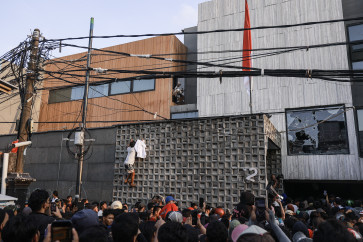Popular Reads
Top Results
Can't find what you're looking for?
View all search resultsPopular Reads
Top Results
Can't find what you're looking for?
View all search resultsSnail curry highly sought in Banyumas during Ramadhan
Several cars and motorcycles were parked outside a food stall on Jl
Change text size
Gift Premium Articles
to Anyone
S
everal cars and motorcycles were parked outside a food stall on Jl. Kauman Lama, Purwokerto, in Banyumas regency, Central Java, on one afternoon as dozens of people lined up to place their orders.
“I’m sorry, the food is all sold out. We are still cooking,” said Lani, 54, who owns the food stall.
Realizing that they had to wait for several more minutes, visitors could only mumble in disappointment.
The popular menu item was gulai keong or freshwater snails cooked in spicy coconut milk. For people living outside Banyumas that may appear an extreme culinary choice but for locals it is a favorite dish, especially during the fasting month of Ramadhan.
Most people are familiar with mutton, beef or chicken cooked in coconut milk with different levels of spiciness. Freshwater snails in coconut milk, however, is most popular in Banyumas particularly during the fasting month.
“It is delicious and a bit spicy. I am a regular customer. I always buy the dish every fasting month,” said Juliana, 34, a resident of Purwokerto.
She added that all food stalls selling snail curry during Ramadhan were thronged by people expecting to break their fast on site. “Now, it is a bit costly. One bowl of snail curry costs Rp 20,000 [US$1.5].”
With high demand for the curry, it is not surprising to see new sellers offering snail curry on roadsides in downtown Purwokerto. This specialty food is generally sold out just minutes before the time for breaking of the fast at dusk.
A popular food stall can sell around 100 kilograms of snail curry on average per day during the fasting month, while Lani’s food stall sells 150 kg of snail curry each day.
The snail curry is sold per kilogram because the snails’ shells are included in the cooking process. A 250 gram serving of snail curry sells for Rp 10,000.
The high demand for snail curry has forced local food stall owners to source snails from areas outside Banyumas regency. Today, they get supplies of freshwater snails from Pemalang and Demak regencies on the north coast of Central Java.
“It is a combination of pleasant savory taste and spiciness. Our family members like it for breaking the fast,” said Bayu, 35, who came all the way from Cilacap, some 50 km south of Purwokerto. He bought 1 kg of snail curry and ate it to break the fast.
Snail curry might be a specialty of Purwokerto but many people outside the small town also enjoy the dish.
Sugiarti, 50, a resident of the western part of Purwokerto, said she usually supplied up to 10 tons of snails every week to food stall owners. “We bring in raw snails from Demak,” she said, adding that it was difficult to get freshwater snails in Banyumas.
Local people in Banyumas call the freshwater snails, which are easily found in freshwater such as in ricefields, ponds, rivers or lakes, kraca. Freshwater snails are a big enemy of the farmers as they eat rice crops.
The mud is washed from the snails to clean them and to reduce any unpleasant smell. Then, the freshly cleaned snails are put in water overnight to clear them up.










